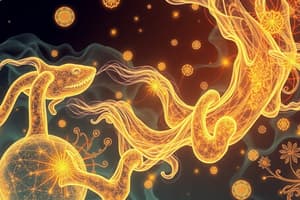Podcast
Questions and Answers
What does the First Law of Thermodynamics state?
What does the First Law of Thermodynamics state?
- Entropy decreases in isolated systems.
- Energy is conserved only in closed systems.
- Energy cannot be created or destroyed. (correct)
- Energy can be created or destroyed.
Which statement accurately describes Le Chatelier’s Principle?
Which statement accurately describes Le Chatelier’s Principle?
- Equilibrium can only be achieved in gaseous reactions.
- A system at equilibrium will shift in response to changes in conditions. (correct)
- A change in temperature does not affect equilibrium.
- A system at equilibrium will remain unchanged under external conditions.
What defines the coordination number in coordination chemistry?
What defines the coordination number in coordination chemistry?
- The oxidation state of the central atom.
- The number of ligands attached to a central atom or ion. (correct)
- The number of electron pairs in the complex.
- The total number of atoms in the complex.
In quantum chemistry, what does the Schrödinger equation describe?
In quantum chemistry, what does the Schrödinger equation describe?
Which of the following is NOT a characteristic of transition metals?
Which of the following is NOT a characteristic of transition metals?
Flashcards are hidden until you start studying
Study Notes
Physical Chemistry
- Definition: Branch of chemistry that deals with the physical properties and phenomena of chemical systems.
- Key Concepts:
- Thermodynamics: Study of energy changes and the laws of energy conservation.
- First Law: Energy cannot be created or destroyed.
- Second Law: Entropy of an isolated system always increases.
- Kinetics: Study of the rates of chemical reactions and the factors affecting them.
- Rate laws: Mathematical expressions that relate reaction rate to concentrations.
- Activation energy: Minimum energy required for a reaction to occur.
- Quantum Chemistry: Application of quantum mechanics to chemical systems.
- Wave-particle duality: Matter displays both particle and wave characteristics.
- Schrödinger equation: Fundamental equation describing how quantum systems evolve.
- Equilibria: Study of reversible reactions and the concept of dynamic equilibrium.
- Le Chatelier’s Principle: A system at equilibrium will shift in response to changes in conditions.
- Thermodynamics: Study of energy changes and the laws of energy conservation.
Inorganic Chemistry
- Definition: Branch of chemistry concerned with inorganic compounds and materials, excluding organic compounds.
- Key Concepts:
- Coordination Chemistry: Study of metal complexes with ligands.
- Coordination number: Number of ligands attached to a central atom or ion.
- Types of ligands: Monodentate, bidentate, polydentate.
- Main Group Elements: Study of properties and reactions of s- and p-block elements.
- Notable groups: Alkali metals, alkaline earth metals, halogens, noble gases.
- Transition Metals: Elements that have partially filled d orbitals.
- Characteristics: Variable oxidation states, colored compounds, catalytic properties.
- Solid-State Chemistry: Study of the synthesis, structure, and properties of solid-phase materials.
- Crystal structures: Arrangement of atoms in a periodic array (e.g., face-centered cubic, hexagonal close-packed).
- Band theory: Explanation of electrical conductivity in solids based on electron energy levels.
- Coordination Chemistry: Study of metal complexes with ligands.
Physical Chemistry
- Definition: Physical chemistry examines the physical properties of chemical systems and the underlying principles that govern their behavior.
- Thermodynamics: Focuses on energy changes in chemical reactions and processes.
- First Law: Energy is conserved; it cannot be created or destroyed, only transformed.
- Second Law: For an isolated system, the entropy always increases over time.
- Kinetics: Investigates the rate at which chemical reactions occur and the factors influencing these rates.
- Rate Laws: Mathematical expressions that relate reaction rate to reactant concentrations.
- Activation Energy: The minimum energy required for a reaction to take place.
- Quantum Chemistry: Applies quantum mechanics to better understand chemical systems.
- Wave-particle Duality: Matter exhibits properties of both waves and particles.
- Schrödinger Equation: A fundamental equation describing the evolution of quantum systems.
- Equilibria: Studies reversible reactions and the concept of dynamic equilibrium.
- Le Chatelier's Principle: A system at equilibrium will shift to counteract changes in conditions, such as temperature, pressure, or concentration.
Inorganic Chemistry
- Definition: Inorganic chemistry focuses on the study of the properties and reactions of compounds that do not contain carbon, excluding basic organic compounds.
- Coordination Chemistry: Examines metal complexes where ligands, molecules or ions, bind to a central metal atom or ion.
- Coordination Number: Number of ligands directly linked to the central metal atom.
- Types of Ligands:
- Monodentate: Binds to the central metal ion through a single atom.
- Bidentate: Binds to the central metal ion through two atoms.
- Polydentate: Can bind to the central metal ion through more than two atoms.
- Main Group Elements: The s- and p-block elements on the periodic table.
- Notable Examples:
- Alkali Metals (Group 1): Highly reactive metals.
- Alkaline Earth Metals (Group 2): Reactive metals that form strong bases.
- Halogens (Group 17): Highly reactive nonmetals, forming salts with metals.
- Noble Gases (Group 18): Very unreactive elements.
- Notable Examples:
- Transition Metals: Elements with partially filled d orbitals.
- Characteristics:
- Variable Oxidation States: Can exist in multiple oxidation states.
- Colored Compounds: Form colored complexes due to d-orbital transitions.
- Catalytic Properties: Act as catalysts in many chemical reactions.
- Characteristics:
- Solid-State Chemistry: Studies the synthesis, structure, and properties of solids.
- Crystal Structures: The periodic arrangement of atoms within a crystal lattice.
- Examples: Face-centered cubic, hexagonal close-packed.
- Band Theory: Explains conductivity in solids based on the allowed energy levels for electrons.
- Crystal Structures: The periodic arrangement of atoms within a crystal lattice.
Studying That Suits You
Use AI to generate personalized quizzes and flashcards to suit your learning preferences.




